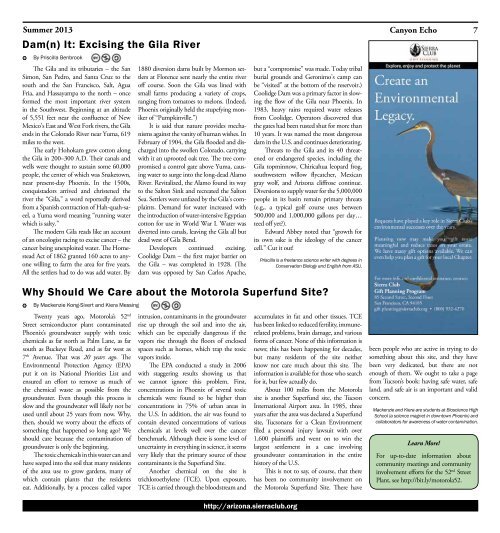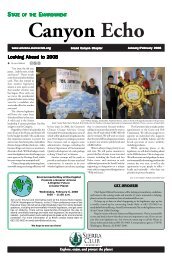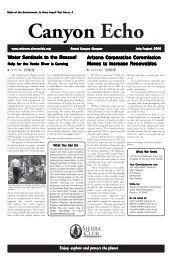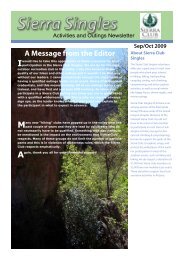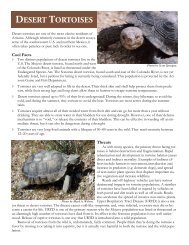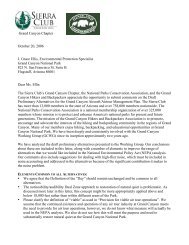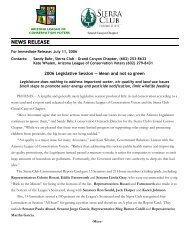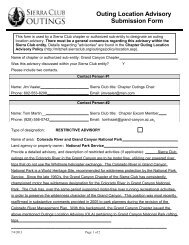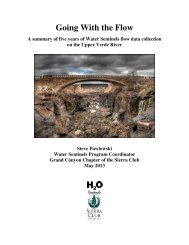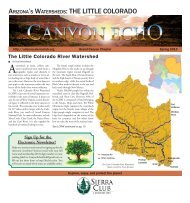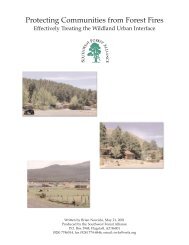Summer 2013 Echo (2.4 MB pdf) - Arizona Sierra Club
Summer 2013 Echo (2.4 MB pdf) - Arizona Sierra Club
Summer 2013 Echo (2.4 MB pdf) - Arizona Sierra Club
You also want an ePaper? Increase the reach of your titles
YUMPU automatically turns print PDFs into web optimized ePapers that Google loves.
<strong>Summer</strong> <strong>2013</strong> Canyon <strong>Echo</strong> 7Dam(n) It: Excising the Gila RiverBy Priscilla BenbrookThe Gila and its tributaries – the SanSimon, San Pedro, and Santa Cruz to thesouth and the San Francisco, Salt, AguaFria, and Hassayampa to the north – onceformed the most important river systemin the Southwest. Beginning at an altitudeof 5,551 feet near the confluence of NewMexico’s East and West Fork rivers, the Gilaends in the Colorado River near Yuma, 619miles to the west.The early Hohokam grew cotton alongthe Gila in 200–300 A.D. Their canals andwells were thought to sustain some 60,000people, the center of which was Snaketown,near present-day Phoenix. In the 1500s,conquistadors arrived and christened theriver the “Gila,” a word reportedly derivedfrom a Spanish contraction of Hah-quah-saeel,a Yuma word meaning “running waterwhich is salty.”The modern Gila reads like an accountof an oncologist racing to excise cancer – thecancer being unexploited water. The HomesteadAct of 1862 granted 160 acres to anyonewilling to farm the area for five years.All the settlers had to do was add water. By1880 diversion dams built by Mormon settlersat Florence sent nearly the entire riveroff course. Soon the Gila was lined withsmall farms producing a variety of crops,ranging from tomatoes to melons. (Indeed,Phoenix originally held the stupefying monikerof “Pumpkinville.”)It is said that nature provides mechanismsagainst the vanity of human wishes. InFebruary of 1904, the Gila flooded and dischargedinto the swollen Colorado, carryingwith it an uprooted oak tree. The tree compromiseda control gate above Yuma, causingwater to surge into the long-dead AlamoRiver. Revitalized, the Alamo found its wayto the Salton Sink and recreated the SaltonSea. Settlers were unfazed by the Gila’s complaints.Demand for water increased withthe introduction of water-intensive Egyptiancotton for use in World War I. Water wasdiverted into canals, leaving the Gila all butdead west of Gila Bend.Developers continued excising.Coolidge Dam – the first major barrier onthe Gila – was completed in 1928. (Thedam was opposed by San Carlos Apache,but a “compromise” was made. Today tribalburial grounds and Geronimo’s camp canbe “visited” at the bottom of the reservoir.)Coolidge Dam was a primary factor in slowingthe flow of the Gila near Phoenix. In1983, heavy rains required water releasesfrom Coolidge. Operators discovered thatthe gates had been rusted shut for more than10 years. It was named the most dangerousdam in the U.S. and continues deteriorating.Threats to the Gila and its 40 threatenedor endangered species, including theGila topminnow, Chiricahua leopard frog,southwestern willow flycatcher, Mexicangray wolf, and <strong>Arizona</strong> cliffrose continue.Diversions to supply water for the 5,000,000people in its basin remain primary threats(e.g,, a typical golf course uses between500,000 and 1,000,000 gallons per day…teed off yet?).Edward Abbey noted that “growth forits own sake is the ideology of the cancercell.” Cut it out!Priscilla is a freelance science writer with degrees inConservation Biology and English from ASU.Why Should We Care about the Motorola Superfund Site?By Mackenzie Kong-Sivert and Kiera MessingTwenty years ago, Motorola’s 52 ndStreet semiconductor plant contaminatedPhoenix’s groundwater supply with toxicchemicals as far north as Palm Lane, as farsouth as Buckeye Road, and as far west as7 th Avenue. That was 20 years ago. TheEnvironmental Protection Agency (EPA)put it on its National Priorities List andensured an effort to remove as much ofthe chemical waste as possible from thegroundwater. Even though this process isslow and the groundwater will likely not beused until about 25 years from now. Why,then, should we worry about the effects ofsomething that happened so long ago? Weshould care because the contamination ofgroundwater is only the beginning.The toxic chemicals in this water can andhave seeped into the soil that many residentsof the area use to grow gardens, many ofwhich contain plants that the residentseat. Additionally, by a process called vaporintrusion, contaminants in the groundwaterrise up through the soil and into the air,which can be especially dangerous if thevapors rise through the floors of enclosedspaces such as homes, which trap the toxicvapors inside.The EPA conducted a study in 2006with staggering results showing us thatwe cannot ignore this problem. First,concentrations in Phoenix of several toxicchemicals were found to be higher thanconcentrations in 75% of urban areas inthe U.S. In addition, the air was found tocontain elevated concentrations of variouschemicals at levels well over the cancerbenchmark. Although there is some level ofuncertainty in everything in science, it seemsvery likely that the primary source of thesecontaminants is the Superfund Site.Another chemical on the site istrichloroethylene (TCE). Upon exposure,TCE is carried through the bloodstream andaccumulates in fat and other tissues. TCEhas been linked to reduced fertility, immunerelatedproblems, brain damage, and variousforms of cancer. None of this information isnews; this has been happening for decades,but many residents of the site neitherknow nor care much about this site. Theinformation is available for those who searchfor it, but few actually do.About 100 miles from the Motorolasite is another Superfund site, the TucsonInternational Airport area. In 1985, threeyears after the area was declared a Superfundsite, Tucsonans for a Clean Environmentfiled a personal injury lawsuit with over1,600 plaintiffs and went on to win thelargest settlement in a case involvinggroundwater contamination in the entirehistory of the U.S.This is not to say, of course, that therehas been no community involvement onthe Motorola Superfund Site. There havebeen people who are active in trying to dosomething about this site, and they havebeen very dedicated, but there are notenough of them. We ought to take a pagefrom Tucson’s book: having safe water, safeland, and safe air is an important and validconcern.Mackenzie and Kiera are students at Bioscience HighSchool (a science magnet in downtown Phoenix) andcollaborators for awareness of water contamination.Learn More!For up-to-date information aboutcommunity meetings and communityinvolvement efforts for the 52 nd StreetPlant, see http://bit.ly/motorola52.http://arizona.sierraclub.org


